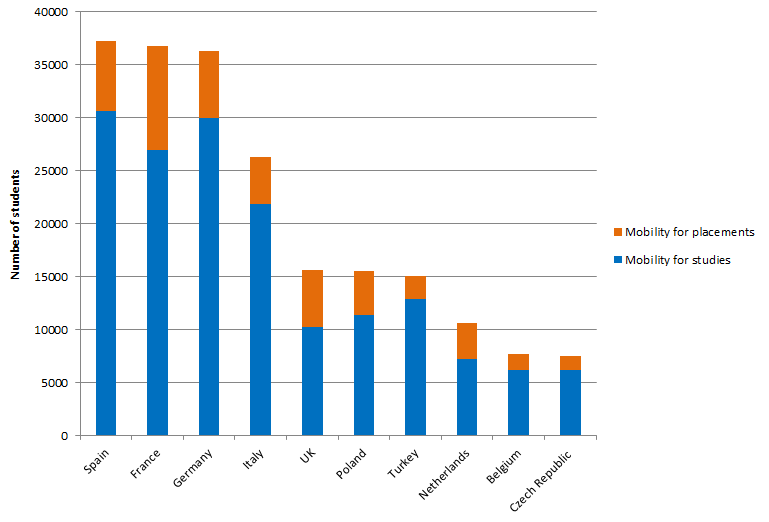Spain, Germany and France are still the most popular destinations for Erasmus students to study or train abroad, according to data from the European Commission.
According to the report Erasmus: Facts, Figures and Trends, Spain received the most Erasmus students (39,277) in 2013-14, followed by Germany (30,964), France (29,621), the UK (27,401) and Italy (20,204). These countries also sent the most students abroad, led again by Spain (37,235). The UK received almost twice as many students as it sent (15,610).
However, France is top when only the number of students doing work placements is considered, while the top destination for students on work placements is the UK.
Overall, a record number of students (272,497) from 3,456 higher education institutions travelled to another European country to study or train through Erasmus in 2013-14, representing a year-on-year increase of 2 per cent. Three-fifths (60.5 per cent) of these students were women.
Students studying social sciences, business and law made up the biggest share (41 per cent) of those on exchanges, followed by those studying humanities and arts subjects (22 per cent).
The figures are based on the number of students who took part in the final academic year (2013-14) of the Erasmus programme for higher education. This has since been replaced by Erasmus+, which provides a wider range of opportunities for students and staff.
Regarding staff mobility through Erasmus, 57,488 staff exchanges were supported in 2013-14, a year-on-year rise of 9.2 per cent. Two-thirds of these (66.3 per cent) were for teaching assignments, while staff training accounted for the rest. This latter share has more than doubled since 2007-08, when it only made up 15 per cent of the total figure. The average duration of a staff mobility period in 2013-14 was 5.5 days.
Poland sent the most staff abroad, followed by Turkey, Spain, Germany and Romania, while the five most popular destinations for staff were Spain, Germany, Italy, the UK and France.
Top 10 sending countries for students in Erasmus programme, 2013-14

Study abroad has greatest impact in Eastern and Southern Europe
Students from Southern and Eastern Europe have the most to gain from undertaking an Erasmus programme.
That is the main finding from a new Erasmus Regional Impact Study from the European Commission, carried out by consultancy CHE Consult, which shows that student exchanges significantly improve young people’s chances of securing high-quality managerial jobs in those regions in particular.
In Southern Europe, Erasmus reduces the risk of long-term unemployment by half compared with non-mobile alumni (3 per cent, compared with 6 per cent), and there is also a significantly lower unemployment rate five to 10 years after graduation (7 per cent, compared with 16 per cent). Furthermore, almost half of Erasmus placement students received a job offer through a work placement abroad – the highest share of all the regions.
Meanwhile, Eastern Europe saw the greatest short-term impact of the programme. Erasmus alumni from the region were significantly more likely to find a job within the first three months after graduation (78 per cent) than non-Erasmus alumni (67 per cent).
Register to continue
Why register?
- Registration is free and only takes a moment
- Once registered, you can read 3 articles a month
- Sign up for our newsletter
Subscribe
Or subscribe for unlimited access to:
- Unlimited access to news, views, insights & reviews
- Digital editions
- Digital access to THE’s university and college rankings analysis
Already registered or a current subscriber?





